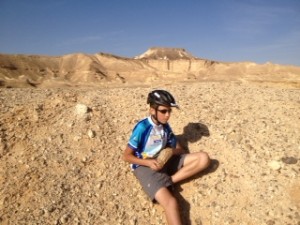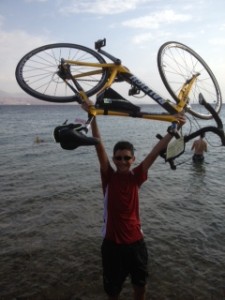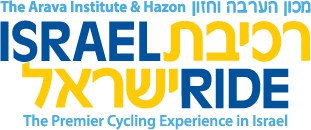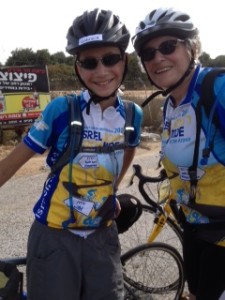In this journal, please share the journey of Rabbi Amy Katz and her son, Gabriel, on the 2012 Israel Ride.
by Amy Katz
We began our ride in northern Israel. There are a total of 60 riders, Gabriel is the youngest and the oldest rider is 69. While many riders come from Massachusetts, others come from 13 other states in the US, Mexico, Australia, Israel and Canada.
Today we rode 52 mile and climbed a total of 2600 feet. We are holding our own and did not have to get in the SAG wagon today. That was our goal for the first day of riding. The ride was stunning. The weather was great ranging between the low 60s, high lower 80s.
After a short bus ride to the heart of the Upper Galilee we officially launched our bike ride at 6:30 am. Gabriel read the traveler’s prayer in Hebrew and one of the crew read the prayer in Arabic and the oldest rider read the prayer in English. The shofar was sounded and we were off. We rode through the forests of the Galil, passing by small rural communities on the Lebanese border.
We descended into the Hula Valley, and visited the bird sanctuary. November is prime bird migration season. Alon Tol, Israel’s leading environmentalist, explained how the swamps that were dried up by the early pioneers have been brought back through the efforts of the government, JNF and local farmers. Alon’s explanation of how this all came to pass was fascinating. After our tour of the area we rode to our hotel, in the far north of Israel near the waters of the Jordan. There were many rolling hills and with a few hard climbs.
One of the most enjoyable aspects of the Israel ride is spending time with the crew, either the lead riders, or the people who make sure that at each rest stop there is food and water. The crew are all students of the Arava Institute, a small school in the Negev that is dedicated to protecting the precious land of Israel while also creating models of coexistence. It is fascinating to spend time with Palestinians, Jordanians, Israelis who work together, respect one another and are eager to find a solution to the Arab-Israeli conflict. I especially enjoy the way the students relate to one another. It is clear they care for one another and they trust each other. Their back and forth is truly refreshing.
Day Two: Goshrin to Bet Shean
Today’s ride was absolutely beautiful and exhausting. We rode a total of 67 miles and climbed 3700 feet. We left our Hotel at 6:30 am and we rode to the lower slopes of the Golan Heights. This 13 mile climb was the most challenging uphill I have ever done. I kept telling myself slow and steady, slow and steady. Gabriel took the hill a bit more easily than I did, that is he rode faster. Main thing — we both rode our bikes for the entire climb.
While enjoying a rest stop at the ancient city of Qatrin, which is the primary home of many Israeli wineries. We had a wonderful discussion about the modern history of the Golan Heights. In addition, we explored various sources of Israel’s primary water — the Jordan River and the Sea of Galilee. Gabriel and I both commented multiple times that the terrain in northern Israel is absolutely gorgeous. Hadas, our tour guide, explained that there are some Israelis who would consider returning the Golan Heights to Syria, if that were to insure a true peace with Syria. We all agreed there is no simple solution to this problem but enjoyed discussing the various possibilities.
After eating, drinking, resting and learning about the Golan Heights we rode to the Kinneret. That 15 mile ride from the Golan to the Kinneret was easier but we have both learned for every up, there is a down! Lunch on the Kinneret was breathtaking. The water is so calm and peaceful. It was exactly what we needed after riding 40 miles. While many of our co-riders jumped into the Kinneret, Gabriel and I enjoyed the quiet, and I must admit I dosed off for a bit.
In the afternoon we rode along the majestic Kinneret and then we made our way to Beit Shean, one of the oldest cities of the world. That ride was exhausting. There was a strong headwind and also the weather was unseasonably hot. Today was in the high 80s. Gabriel and I both felt physically overwhelmed — but neither of us wanted to get in the van. So we persevered! One of the lead riders was in awe of Gabriel’s determination. Today’s ride was 67 miles. At mile 63, Gabriel decided he had had enough and it was time to get in the van. There he discussed Israeli and American politics with the other riders.
Of course as soon as we arrived in the hotel, Gabriel was listening to podcasts and enjoying a quiet evening resting. We both had a great day.
This itinerary is wonderful because it allows us to explore Israel and learn about the country and we both feel physically challenged, and very proud that we are able to do this ride.
Day 3: Yerucham to Mitzpe Ramon
We spent Thursday night at the youth hostel in Bet She’an. The timing of Friday was somewhat off, as we first took a bus from Bet She’an to a small development town in the Negev, known as Yerucham. We only began riding our bicycles at about 9:30 am and already it was 90 degrees outside. The weather is unseasonably warm and that made the ride very difficult for many riders today. After launching our ride in Yerucham, we rode to Ben Gurion’s grave at Sde Boker.
As we rode through the desert, we noticed how different the terrain is. While the Galilee is very lush with beautiful trees and some breathtaking flowers, the Negev is very brown.
On Friday we rode 48 miles and climbed 3600 feet. The hills were less steep, but the heat was intense. So that made for some difficult riding. By 3:00 when we arrived in our hotel at Mitzpe Ramon, we were absolutely exhausted.
Gabriel suffered some heat exhaustion on Friday and as a result he got in the van around 1:00 in the afternoon. He was very disappointed to miss the last 20 miles, but it was too hot for him and I wanted to prevent his getting really sick. In the van, Gabriel spent a lot of time speaking to the bike mechanic about Israeli politics and environmental issues in Israel.
We have both enjoyed meeting our co-riders. In the course of the day we rode next to so many interesting people, who care very much for Israel. We have so much to talk about with our fellow riders.
Shabbat was nice, quiet and very relaxing.
Day 4: Mitzpe Ramon to Kibbutz Ketura
Sunday was a great ride. We rode 65 miles and climbed 3200 feet from Mitzpeh Ramon to Kibbutz Ketura. We had significant downhills and lots of rolling hills. The ride began with a spectacular descent into Makhtesh Ramon. Afterwards we traveled across the heart of the ever-changing Negev landscape. We stopped for lunch at a desert Ashram and an organic cafe.
 The terrain is mostly rolling hills — so it was really great riding. We stopped at another organic farm for some homemade ice cream and then enjoyed one last dramatic descent to the Arava Valley. At the bottom of the descent there is the THE MOST GORGEOUS GROVE OF DATE TREES. We arrived at the Kibbutz around 3:00 and had a chance to learn about the academic research of the Arava Institute.
The terrain is mostly rolling hills — so it was really great riding. We stopped at another organic farm for some homemade ice cream and then enjoyed one last dramatic descent to the Arava Valley. At the bottom of the descent there is the THE MOST GORGEOUS GROVE OF DATE TREES. We arrived at the Kibbutz around 3:00 and had a chance to learn about the academic research of the Arava Institute.
Hard to believe that tomorrow is our last day of riding.
One other special part of today’s ride. The organizers of the Israel Ride brought along a very small Torah (the kind that kids carry on Simhat Torah, the Torah is about the size of my hand from the bottom of my palm to the top of my longest finger). Each day someone else in the ride is invited to carry the Torah and talk about what that experience meant to them. This morning, some of our fellow riders gave the small Torah to Gabriel. They explained that it is important to make sure that the next generation has access to the Torah and they believed Gabriel represented the next generation. Gabriel and I had some nice conversations about what it means to carry the Torah. I know he was honored to be given the Torah and that made Sunday’s riding that much more special.
There was an important lesson for me in Gabriel’s carrying the Torah. I had my own ideas about where Gabriel should put the Torah while we were riding in the desert. He insisted on doing it his way. As parents, Ken and I have devoted much of our energy to making sure our children have access to Torah. But as they become more mature, we have to let them practice Judaism in their own way. Our job as parents is to teach about Judaism, to be very clear about why Judaism is important to us. As our children grow older we have to allow them to hold on to to Torah in their own way. Throughout our ride on Sunday I thought about Gabriel’s and my brief conversation about how he should carry this small Torah.
Day 5: Kibbutz Keturah to Eilat
Gabriel and I had a great final day of riding. We rode a total of 48 miles and climbed 3200 feet in the course of the day. Most of the ride on Monday was along the Egyptian border. It was strange for me. I have cycled this ride five times already. And there was never a fence on the border between Egypt and Israel. In fact, in the past I have marveled that if one wanted it would be easy to go back and forth between Israel and Egypt. I learned that this border has been the source of many problems for Israel. On at least one occasion Egyptians tanks wandered into Israel and attacked an Israeli bus. In addition, more than 60,000 African migrants have walked into Israel in recent years, some seeking work and others refuge. These illegal migrants have stirred fear for public order and demographics. For these two reasons the Netanyahu government has built a fortified and closely patrolled fence between Israel and the Egyptian Sinai Peninsula.
The ride on Monday was difficult. In the morning there was a very strong headwind and we were riding up a gradual hill. There were rest stops every 8 or 10 miles. Gabriel and I needed each break! Mid-morning, the wind died down, the sun came out and the riding became much easier. After lunch we enjoyed a stunning descent into the city of Eilat, where Gabriel led the group through the city to the beach. After a swim in the Red Sea we packed our bicycles and enjoyed a final dinner.
We left for Jerusalem on Tuesday morning and spent a couple of days there before flying home late Wednesday evening.
As we reflect upon our travels, we both observed that the different landscapes in the north and south are stunning. The north is so lush and beautiful and the desert is so barren. Also we noted that the bodies of water we visited look and feel so very different. Within 6 days we had a chance to dip in the Mediterranean Sea, the Kinneret, and the Red Sea. We both felt that cycling around Israel is a perfect way to enjoy the land. The scenery is stunning and we were able to focus on our surroundings in a way we would not have, had we been in a car or bus. We also enjoyed the exercise and feel incredibly proud of ourselves. This was a difficult ride and we did it!
On a different note, both Gabriel and I felt great about the Arava Institute. We were so impressed by the projects that are researched and implemented by the Arava Institute and its graduates. The Arava Institute is protecting the natural resources of the land of Israel and really making a difference. The projects are too complicated to be described in an email, but if you are interested in learning more about the work of the Arava Institute check out www.arava.org.
I should add that seeing Jordanians, Israeli Jews, Palestinians from East Jerusalem and the West Bank learn together gives me hope for the future. I thought you would enjoy the following cute story. Later that evening, a Palestinian from East Jerusalem approached one of the leaders and asked why we didn’t use the right tune. He has been attending Shabbat dinner weekly, since as a student at the Arava Institute he lives on Kibbutz Ketura. Mohammed has learned to appreciate Jewish rituals and enjoys Friday night traditions. And of course, he now has his favorite tunes!
I love that at the Institute, Palestinians live with Israelis and and learn about Jewish customs. I also love that Israelis are forced to learn about the Palestinians’ claim to the land of Israel. In my opinion, peace will never come until both sides don’t learn to honor and respect the other.
Gabriel is a bit more pessimistic. He worries that the Institute is too small to really make a difference. I feel that whenever we are able to, we should support communities of coexistence, especially when the narrative of both the Jews and the Israelis is being honored. I want to change this world one soul at a time.
While on the ride we also learned a great deal about the work of an organization in the United States known as Hazon. Gabriel was really inspired by Hazon. He goes to Ramah Outdoor Adventure and he spends a lot of time learning about the environment and the foods that we eat. As an ideological vegetarian, the message of Hazon spoke to Gabriel.
As Jews, we’ve been thinking about kashrut – about what is “fit” to eat – for nearly 3,000 years. And a growing number of people today realize that our food choices have significant ramifications – for ourselves, our families and the world around us. Hazon stands at the forefront of a new Jewish Food Movement, leading Jews to think more broadly and deeply about our own food choices. We’re using food as a platform to create innovative Jewish educational programs; to touch people’s lives directly; to strengthen Jewish institutions; and in the broadest sense to create healthier, richer and more sustainable Jewish communities.
 One final thought, I especially loved that as we were cycling in the Negev, the Torah portions we are reading describe Abraham’s journey in the land. The text seemed relevant in a new way. One small example, the Torah portion read last Shabbat includes a description of Abraham sending his handmade Hagar and their son Ishmael off into the desert. The text tells us that Hagar worried that they did not have enough water and that at one point she sat down in despair, worrying that they would not survive the harsh environment. The Torah tells us that Hagar was especially worried about Ishmael. I related to Hagar in a way I never had before. Throughout our ride, I was constantly filling Gabriel’s camelback. I was so worried that at some point he would forget to refill his camelback and he would become thirsty and there would be no water around. I worried about Gabriel in a way I never had before. And honestly, I worried much more about Gabriel than I did about myself!
One final thought, I especially loved that as we were cycling in the Negev, the Torah portions we are reading describe Abraham’s journey in the land. The text seemed relevant in a new way. One small example, the Torah portion read last Shabbat includes a description of Abraham sending his handmade Hagar and their son Ishmael off into the desert. The text tells us that Hagar worried that they did not have enough water and that at one point she sat down in despair, worrying that they would not survive the harsh environment. The Torah tells us that Hagar was especially worried about Ishmael. I related to Hagar in a way I never had before. Throughout our ride, I was constantly filling Gabriel’s camelback. I was so worried that at some point he would forget to refill his camelback and he would become thirsty and there would be no water around. I worried about Gabriel in a way I never had before. And honestly, I worried much more about Gabriel than I did about myself!
Throughout the ride, I reminded Gabriel about the Torah portions from Genesis. It was really important to me that this bike ride was not just about physical accomplishment, but that it also was a way for Gabriel to relate to the Torah. I think that the Israelites’ wandering in the desert for 40 years and Abraham and Isaac’s experiences in the land are more accessible to Gabriel now that his has spent time cycling in the land himself.
The trip has been terrific and we are both excited ready to come home., albeit just for a week!






No comments yet.